7 books about Baym, Nina
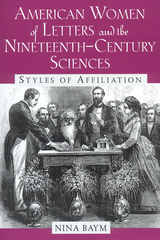
American Women of Letters and the Nineteenth-Century Sciences
Styles of Affiliation
Baym, Nina
Rutgers University Press, 2001
Winner of the 2000 Hubbell Award from the American Literature Section of the Modern Language Association of America
Choice Outstanding Academic Title
During the nineteenth century, the content and institutional organization of the sciences evolved dramatically, altering the public's understanding of knowledge. As science grew in importance, many women of letters tried to incorporate it into a female worldview. Nina Baym explores the responses to science displayed in a range of writings by American women. Conceding that they could not become scientists, women insisted, however, that they were capable of understanding science and participating in its discourse. They used their access to publishing to advocate the study and transmission of scientific information to the general public.
Bayms book includes biographies and a full exploration of these women's works. Among those considered are:
• Almira Phelps, author of Familiar Lectures on Botany (it sold 350,000 copies)
• Sarah Hale, who filled Godey's Lady's Book with science articles
• Catharine Esther Beecher, who based her domestic advice on scientific information
• Elizabeth Cary Agassiz, the actual ghostwriter of her husband's popular science essays
• Emily Dickinson, whose poetry is replete with scientific images.
Baym also investigates science in women's novels, writing by and about women doctors, and the scientific claims advanced by women's spiritualist movements. This book truly breaks new ground, outlining a field of inquiry that few have noted exists.
Choice Outstanding Academic Title
During the nineteenth century, the content and institutional organization of the sciences evolved dramatically, altering the public's understanding of knowledge. As science grew in importance, many women of letters tried to incorporate it into a female worldview. Nina Baym explores the responses to science displayed in a range of writings by American women. Conceding that they could not become scientists, women insisted, however, that they were capable of understanding science and participating in its discourse. They used their access to publishing to advocate the study and transmission of scientific information to the general public.
Bayms book includes biographies and a full exploration of these women's works. Among those considered are:
• Almira Phelps, author of Familiar Lectures on Botany (it sold 350,000 copies)
• Sarah Hale, who filled Godey's Lady's Book with science articles
• Catharine Esther Beecher, who based her domestic advice on scientific information
• Elizabeth Cary Agassiz, the actual ghostwriter of her husband's popular science essays
• Emily Dickinson, whose poetry is replete with scientific images.
Baym also investigates science in women's novels, writing by and about women doctors, and the scientific claims advanced by women's spiritualist movements. This book truly breaks new ground, outlining a field of inquiry that few have noted exists.
[more]
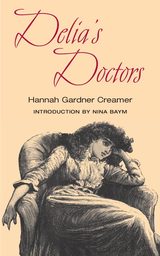
Delia's Doctors; or, A Glance behind the Scenes
Hannah Gardner Creamer
University of Illinois Press, 2002
A lost 19th century novel focused on several women's issues, especially female health; with a fascinating view of mid-nineteenth-century medical practices.
This early feminist novel is a wickedly funny slice of mid-nineteenth-century Americana peppered with details of the era’s freakish medical tactics and leavened with a smart and sassy commentary about the societal restraints on women’s physical and intellectual abilities.
First published in 1852, Delia’s Doctors is one of four known novels by Hannah Gardner Creamer, an American writer whose life and career have been all but absent from the annals of American history. In the book, eighteen-year-old Delia Thornton is ill. Her condition, more psychological than physical, worsens during the bitter winter, even as doctor after doctor attempts to cure her.
As Delia typifies the female heroine whose sickness is aggravated by listlessness and inactivity, her brother’s fiancée, Adelaide Wilmot, is Delia’s more robust counterpart. Adelaide thinks she could do anything, if only she were a man, and she dreams of being a physician. Quick to point out the shortcomings of male doctors in treating female illnesses, Adelaide saves Delia and delivers a series of arguments against New England patriarchy.
This early feminist novel is a wickedly funny slice of mid-nineteenth-century Americana peppered with details of the era’s freakish medical tactics and leavened with a smart and sassy commentary about the societal restraints on women’s physical and intellectual abilities.
First published in 1852, Delia’s Doctors is one of four known novels by Hannah Gardner Creamer, an American writer whose life and career have been all but absent from the annals of American history. In the book, eighteen-year-old Delia Thornton is ill. Her condition, more psychological than physical, worsens during the bitter winter, even as doctor after doctor attempts to cure her.
As Delia typifies the female heroine whose sickness is aggravated by listlessness and inactivity, her brother’s fiancée, Adelaide Wilmot, is Delia’s more robust counterpart. Adelaide thinks she could do anything, if only she were a man, and she dreams of being a physician. Quick to point out the shortcomings of male doctors in treating female illnesses, Adelaide saves Delia and delivers a series of arguments against New England patriarchy.
[more]
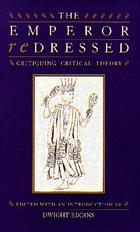
The Emperor Redressed
Critiquing Critical Theory
Dwight Eddins
University of Alabama Press, 1995
There have been signs now, for some time, that poststructuralist hegemony is declining. This book helps us to understand the theoretical flaws that make this decline inevitable.
The essays in this volume represent a collective questioning of the poststructuralist ascendancy, and of the assumptions involved therin, by a group of our most prominent scholars. These scholars were charged with examining the truth-value, methodology, practice, and humanistic status of poststructuralist theories and with speculating on what their conclusions portend for the future of theory. They provide cogent evidence that the poststructuralist heyday has passed.
The essays in this volume represent a collective questioning of the poststructuralist ascendancy, and of the assumptions involved therin, by a group of our most prominent scholars. These scholars were charged with examining the truth-value, methodology, practice, and humanistic status of poststructuralist theories and with speculating on what their conclusions portend for the future of theory. They provide cogent evidence that the poststructuralist heyday has passed.
[more]

Feminism and American Literary History
Essays
Baym, Nina
Rutgers University Press, 1992
Bodies may be currently fashionable in social and feminist theory, but their insides are not. Biological bodies always seem to drop out of debates about the body and its importance in Western culture. They are assumed to be fixed, their workings uninteresting or irrelevant to theory. Birke argues that these static views of biology do not serve feminist politics well. As a trained biologist, she uses ideas in anatomy and physiology to develop the feminist view that the biological body is socially and culturally constructed. She rejects the assumption that the body's functioning is somehow fixed and unchanging, claiming that biological science offers more than just a deterministic narrative of 'how nature works'. Feminism and the Biological Body puts biological science and feminist theory together and suggests that we need a politics which includes, rather than denies, our bodily flesh.
[more]
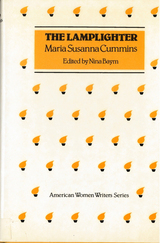
'The Lamplighter' by Maria Susanna Cummins
Baym, Nina
Rutgers University Press, 1988
The Lamplighter was the first novel by twenty-seven-year-old Maria Susanna Cummins. It propelled her into a prominence that continued until her early death at the age of thirty-nine. A novel of female development, The Lamplighter is a woman's version of the quest story. Its heroine, Gerty, comes on the scene as a child abandoned in the slums of Boston. Rescued by the kindly lamplighter Trueman Flint, she learns to meet life with courage and honesty. The novel touched the hearts, validated the ideals, and assuaged the anxieties of a huge readership, and it remained continuously in print until the 1920s.
[more]
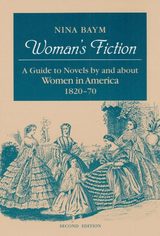
Woman's Fiction
A Guide to Novels by and about Women in America, 1820-70
Nina Baym
University of Illinois Press, 1993
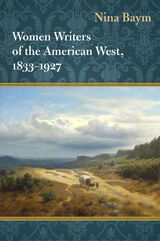
Women Writers of the American West, 1833-1927
Nina Baym
University of Illinois Press, 2012
Women Writers of the American West, 1833–1927 recovers the names and works of hundreds of women who wrote about the American West during the nineteenth and early twentieth centuries, some of them long forgotten and others better known novelists, poets, memoirists, and historians such as Willa Cather and Mary Austin Holley. Nina Baym mined literary and cultural histories, anthologies, scholarly essays, catalogs, advertisements, and online resources to debunk critical assumptions that women did not publish about the West as much as they did about other regions. Elucidating a substantial body of nearly 650 books of all kinds by more than 300 writers, Baym reveals how the authors showed women making lives for themselves in the West, how they represented the diverse region, and how they represented themselves.
Baym accounts for a wide range of genres and geographies, affirming that the literature of the West was always more than cowboy tales and dime novels. Nor did the West consist of a single landscape, as women living in the expanses of Texas saw a different world from that seen by women in gold rush California. Although many women writers of the American West accepted domestic agendas crucial to the development of families, farms, and businesses, they also found ways to be forceful agents of change, whether by taking on political positions, deriding male arrogance, or, as their voluminous published works show, speaking out when they were expected to be silent.
[more]
READERS
Browse our collection.
PUBLISHERS
See BiblioVault's publisher services.
STUDENT SERVICES
Files for college accessibility offices.
UChicago Accessibility Resources
home | accessibility | search | about | contact us
BiblioVault ® 2001 - 2024
The University of Chicago Press









